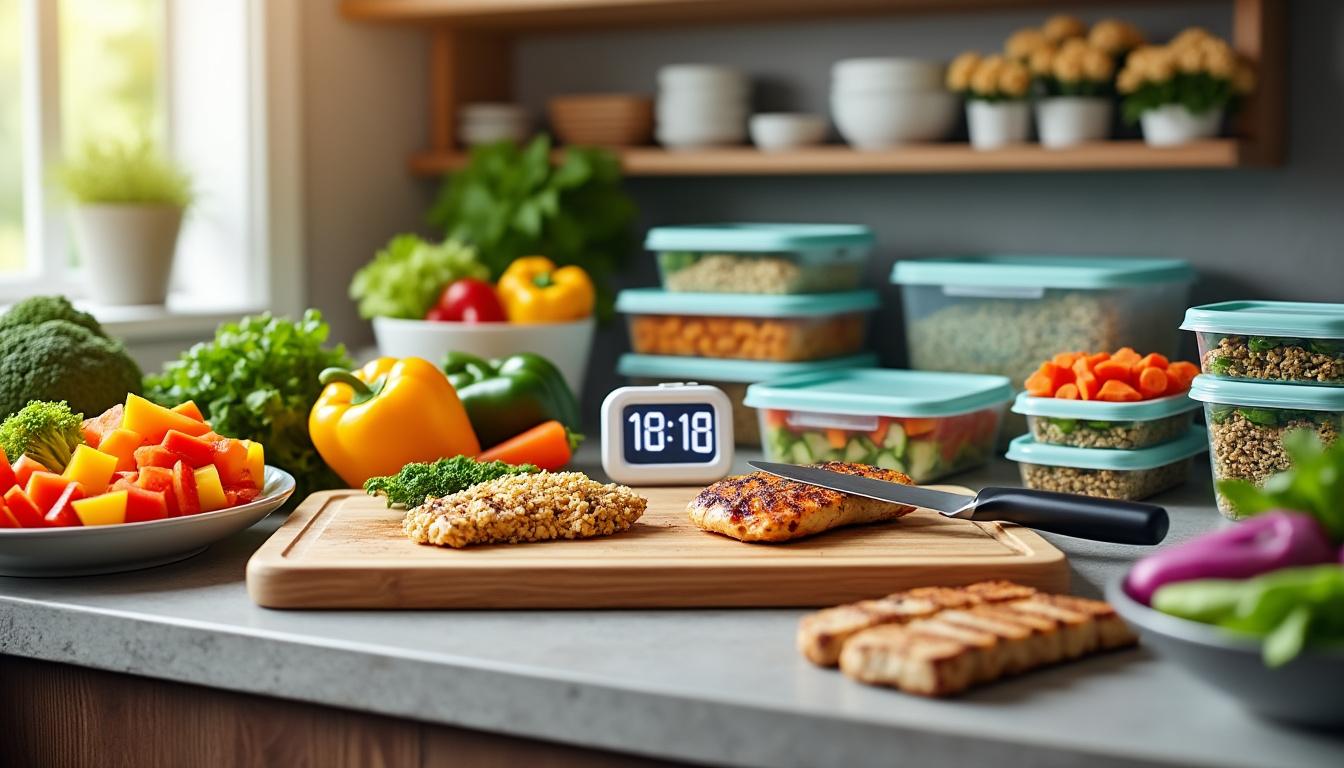In the fast-paced world of 2025, busy professionals and families increasingly seek efficient strategies to maintain healthy eating habits without sacrificing valuable time. Meal prep—a planning and preparation technique that condenses multiple meals into a shortened cooking session—has emerged as a powerful method to reconcile time constraints with nutritious, varied meals throughout the week. Dispelling outdated notions of meal prep as monotonous or time-consuming, modern approaches enable preparing diverse and flavorful weekly meals in just one hour. This revolution not only accelerates meal planning and cooking but also supports fitness goals, portion control, and balanced nutrition, appealing to a wide spectrum from entrepreneurs to home cooks striving for easy cooking solutions.
Understanding the importance of effective meal prep is critical in integrating it into daily routines. It maximizes time-saving without compromising delight or healthfulness, offering a blend of quick recipes and wholesome ingredients that align with a 2025 lifestyle’s demands. By leveraging innovative meal planning methodologies, one can reduce weekday stress, minimize reliance on expensive takeout, and cultivate better dietary discipline. This article elaborates on professional, practical ways to master meal prep in just one hour, ensuring a seamless week of nutritious meals.
Strategic Meal Planning for One-Hour Meal Prep Success
Successful meal prep begins with comprehensive, strategic meal planning. Diligence in this phase optimizes the use of an hour in the kitchen, aligning dishes with nutritional goals and ensuring a balanced weekly meals lineup. This planning minimizes the guesswork and repetitive trips to the store, enabling more efficient grocery shopping and ingredient utilization.
Key elements of efficient meal planning include:
- Defining Meal Variety: Incorporate a mixture of proteins, vegetables, and grains to prevent meal fatigue. Rotating between salmon, chicken, legumes, and vegetarian options encourages diverse nutrient intake and flavor profiles.
- Assessing Time Investment per Meal: Select recipes with overlapping cooking temperatures and similar preparation techniques to streamline cooking tasks.
- Creating a Master Grocery List: Based on recipes selected, consolidate all ingredients into a precise, organized shopping list facilitating a quick supermarket run.
- Considering Portion Control: Determine realistic portion sizes to satisfy dietary needs, avoid food waste, and aid fitness meal objectives.
A practical example involves batch cooking proteins that can serve multiple meals, such as roast chicken breasts used in both tacos and hearty soup later in the week. This ‘cook once, eat twice’ technique drastically reduces prep time while maintaining variety.
| Meal Prep Planning Step | Details | Example |
|---|---|---|
| Meal Variety | Mix of different proteins and vegetables | Salmon, lentils, turkey, and vegetarian options |
| Cooking Round Efficiency | Utilize matching oven temperatures to cook multiple dishes simultaneously | Bake chicken and roast vegetables at 375°F together |
| Grocery List Creation | Organized by ingredient types and recipes | One combined list for all five dinner meals |
| Portion Control | Measure to meet daily calorie and protein targets | 4 oz chicken breast per serving with ½ cup veggies |
For additional guidance on organizing a compact cooking space effectively, consult resources on how to organize a small kitchen. This strategy boosts workflow and maximizes the limited time during meal prep.
Preparation Techniques to Maximize Efficiency in 60 Minutes
When planning to meal prep for the week in just one hour, mastering certain preparation techniques proves essential. Efficiency relies upon multitasking, prioritization, and pre-coordination of ingredients and equipment to eliminate downtime and streamline food assembly.
Consider these pivotal preparation techniques:
- Preheat and Plan Oven Use: Preheat to a single temperature accommodating multiple dishes simultaneously, such as 375°F, streamlining baking and roasting.
- Wash and Chop in Batches: Clean and slice all vegetables and aromatics in one session to expedite assembly later in the week.
- Leverage ‘Cook Once, Eat Twice’ Ingredients: Prepare proteins like chicken and lentils once, then integrate them across multiple meals including salads, soups, and entrees.
- Prepare Sauces and Dressings Ahead: Whisk together homemade sauces to enhance meal flavor without last-minute effort.
- Freeze Portions if Necessary: Properly freeze some prepped ingredients or partially cooked meals to maintain freshness.
Example workflow: While chicken bakes, lentils simmer on the stove; simultaneously, vegetables are chopped; finally, sauces are whisked and dressings prepared—all within a tightly choreographed hour.
| Task | Details | Time Allocated |
|---|---|---|
| Oven Preheating and Baking Chicken | Season and bake chicken breasts for multiple dishes | 15-20 minutes |
| Cooking Lentils | Simmer lentils for use in salads and side dishes | 15-20 minutes |
| Chopping Vegetables | Dice tomatoes, celery, carrots, onions, garlic, and peppers together | 15 minutes |
| Making Sauces and Dressings | Mix lemon herb sauce, balsamic dressing, and other condiments | 10-15 minutes |
More inspiration and detailed strategies for cheap, easy dinners under $10 can be found at this resource, ensuring affordable, quick recipes fit nicely into weekly meal planning.
Batch Cooking and Portion Control to Support Healthy Eating and Fitness Meals
Batch cooking is a foundational principle in meal prep, enabling the production of multiple servings simultaneously without added effort. This approach fosters portion control, essential for managing calorie intake and aligning with fitness goals. It mitigates overeating risk while simplifying calorie tracking.
Implementing batch cooking involves:
- Standardizing Portion Sizes: Pre-divide proteins, grains, and vegetables into individual meal portions during prep to prevent last-minute guesswork.
- Using Multi-Compartment Containers: Store balanced meals with separated food groups to maintain texture and ensure nutrient variety.
- Integrating Nutrient-Dense Foods: Include lean proteins, whole grains, and fibrous vegetables to boost meal satiety and energy.
- Rotating Meal Components Weekly: Avoid repetition by swapping out side dishes or proteins to sustain interest and nutrition quality.
Table 3 demonstrates a sample weekly meal prep menu balancing proteins and carbs with calorie and protein counts designed for active adults.
| Meal | Main Ingredients | Calories | Protein (g) | Carbohydrates (g) |
|---|---|---|---|---|
| Lemon Herb Baked Salmon with Lentils & Tomatoes | Salmon, lentils, tomatoes, lemon herb sauce | 450 | 33 | 42 |
| Chicken Tinga Tacos | Chicken, chipotle sauce, tortillas, onions | 550 | 45 | 50 |
| Lentil Spinach Salad with Pears & Walnuts | Lentils, spinach, pears, walnuts, goat cheese | 480 | 30 | 35 |
| Italian Chicken Noodle Soup | Chicken, ditalini pasta, kale, broth | 460 | 40 | 45 |
| Turkey Chorizo Burgers with Crudités | Turkey chorizo, carrot & celery sticks, fruit | 500 | 48 | 38 |
Such nutritional balance supports sustained energy levels and efficient recovery for fitness enthusiasts and wellness-focused individuals.
Leveraging Freezer-Friendly and Fresh Meal Components to Enhance Weekly Meals
Balancing freezer-friendly prep with fresh ingredients ensures spectrum-rich, delicious, and safe weekly meals. Certain dishes or components retain optimal quality after freezing, while others are better fresh to preserve texture and flavor.
Best practices when mixing frozen and fresh elements include:
- Freezing Cooked Proteins or Partial Meals: Freeze soups, stews, or patties formed during prep day to extend shelf life without sacrificing nutrient integrity.
- Adding Fresh Ingredients on Dish Days: Chop fresh herbs, slice avo and cheese, or mix salad greens at serving moment for maximum freshness.
- Ensuring Safe Food Handling: Freeze meals within recommended timelines, defrost appropriately, and cook or reheat thoroughly.
- Planning Meal Sequence Accordingly: Schedule freezer meals for end of the week to optimize freshness and prevent waste.
An example sequence: freeze turkey chorizo burger patties prepared on prep day, then bake or grill them fresh on Friday alongside pre-chopped vegetable crudités prepared earlier in the week. Soup ingredients may be frozen and thawed overnight before quick assembly.
These approaches save time and maintain a balanced diet all week long, turning meal prep into a sustainable, enjoyable habit. For additional insights on managing household costs in conjunction with meal prep, consult monthly budget strategies for 2025 and tips to save on house and rent expenses for families.
Quick Assembly and Cooking on Weeknights Supporting Easy Cooking and Time-Saving
The final phase of meal prep is effortless assembly and cooking across weekly dinners. With thorough preparation done ahead, weeknight cooking is reduced to a series of simple steps, fostering less stress and more confidence in healthy eating.
Strategies for speedy meal-day actions include:
- Minimal Additional Chopping: Reserve chopping fresh garnishes or perishable items for day of serving to maximize freshness and flavor.
- Reheating Techniques: Employ oven baking, sautéing, or quick simmer methods to finish meals efficiently.
- Building Diverse Dishes from Base Ingredients: Use pre-cooked proteins and veggies combined with fresh components to create different meals such as tacos, salads, or noodle soups.
- Timing Prep According to Schedule: Plan lighter meals for busier evenings attainable within 5–10 minutes.
For instance, Monday’s lemon herb salmon dinner requires simply baking the salmon and sautéing pre-chopped tomatoes and lentils with olive oil, finished by drizzling the pre-made sauce—ready within 20 minutes. Midweek salad assembly demands only slicing pears and drizzling dressing, perfect for time-crunched days.
| Weeknight | Meal | Quick Tasks | Estimated Time |
|---|---|---|---|
| Monday | Lemon Herb Baked Salmon with Lentils & Tomatoes | Bake salmon, sauté veggies, add sauce | 20 minutes |
| Tuesday | Chicken Tinga Tacos | Chop fresh herbs, make tinga sauce, simmer chicken | 25 minutes |
| Wednesday | Lentil Spinach Salad with Pears & Walnuts | Slice fruit, toss salad with dressing | 10 minutes |
| Thursday | Italian Chicken Noodle Soup | Sauté veggies, add stock and pasta, simmer | 30 minutes |
| Friday | Turkey Chorizo Burgers with Crudités | Bake burgers, prepare crudités, plate | 20 minutes |
Prioritizing these quick assembly techniques bolsters meal prep’s main advantages: time-saving without sacrificing nutrition or taste. Those looking for additional inspiration may visit Daily Bakersfield News, a hub for contemporary healthy recipes and lifestyle tips.

